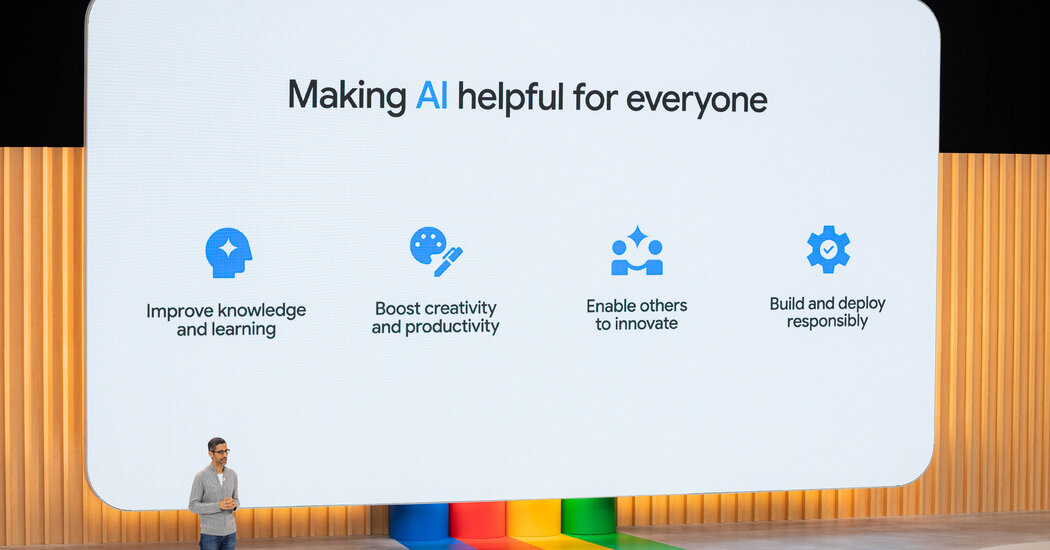When San Francisco start-up OpenAI released ChatGPT late last year, the AI chatbot appeared to be Google’s first major threat in decades. One day, tech insiders thought, it could make Google’s Internet search engine look old and badass.
Google executives promised a swift response to protect the company’s $162 billion franchise and said artificial intelligence would be woven into all products from the search engine to email.
On Wednesday, at its annual conference in Mountain View, California, the company demonstrated some of what it’s been working on. Google said its search engine will start including AI-generated answers at the top of search results pages, allowing users to ask follow-up questions.
It was a notable step toward Google’s embrace of AI, which many experts believe could reshape the tech industry. Google pioneered the technology, but was hesitant to do too much with it because AI carries risks, such as spreading false information.
But Google, along with the rest of Silicon Valley, was surprised by ChatGPT’s success. In December, Google declared a “code red” to find ways to incorporate the technology behind ChatGPT, called generative AI, into its own products.
Google said at its conference on Wednesday that it has now embedded its latest AI technology into 25 products, including the search updates and a feature to help users write emails in Gmail.
“Seven years into our journey as an AI-first company, we are at an exciting turning point,” Google CEO Sundar Pichai said at the conference. “With generative AI we are taking the next step, with a bold and responsible approach we are reimagining all our products.”
The company also doubled down on its hardware ambitions, releasing two new smartphones and a tablet. At the high end was the Pixel Fold, Google’s first foldable phone. For budget-conscious people, it offered the Pixel 7A, a phone that costs $500. The company has made its Pixel tablet both portable and capable of docking on a speaker so it can function as a smart home display.
Google is racing against OpenAI and its partner Microsoft. In February, Microsoft demonstrated how the latest version of Microsoft’s search engine, Bing, includes a chatbot that works with the technology developed by OpenAI.
But Google still takes a more measured approach than its main competitors. The company has not included a chatbot, which is prone to fabricating false information, in its search engine. Instead, Google said it will use AI to provide some answers, which will be confirmed by authoritative websites, and will continue to include ads in comments.
Liz Reid, a vice president of Google Search, said in an interview ahead of the conference that users expected the company to have high-quality information and it didn’t want to undermine that trust.
“The technology is early,” Ms. Reid said. “It’s great in some ways and it has a lot of challenges in other ways.”
To work with the latest search features, users must sign up for Search Labs, a new effort that allows users and the company to test experimental features. The New York Times previously reported that Google will allow up to 30 million people in the United States to use the updates by the end of the year.
In March, Google released Bard, an experimental chatbot intended to compete with ChatGPT. Google broadened access to the tool on Wednesday, bringing it to more than 180 countries and territories in English and also offering it in Japanese and Korean.
Mr. Pichai also discussed the company’s efforts to build more powerful AI technology. He unveiled the latest version of that more powerful technology, Pathways Language Model 2, or PaLM 2, and said work had begun on an even bigger model called Gemini.
AI models are the massive systems used to develop artificial intelligence, and so far only a handful of companies have the resources to develop them. While protecting its search business is vital to the company’s future, Google could make billions by allowing other companies to use its cloud computing services to develop their own AI services.
Google said it made Bard, which can generate emails, shopping lists and poems, more intelligent and creative by running it on PaLM 2. The chatbot can display and interpret images and allows users to export responses to Gmail, Docs and other applications.
The company has begun integrating generative AI into its Workspace applications, including Gmail, Docs, and Sheets. Users can use short text descriptions to create images for a slideshow or draft documents, with options to change the writing style to be more professional or casual.
Since the introduction of ChatGPT, Google has faced criticism from tech industry insiders that it hadn’t moved fast enough to improve search. But Ms Reid said the company’s sheer number of users was “the refrain we should listen to the loudest”.
“There are still huge opportunities in the world to meet people’s information needs and there will always be a lot of people trying to solve it, and I think that’s great,” she said. “It will help us – help everyone – evolve.”
Investors have been closely following Google’s AI progress and are concerned about the competitive threat from OpenAI and Microsoft. Mark Mahaney, an analyst at Evercore ISI, said in an interview that this year’s presentation did not “end the concerns, but partially addresses them.”
“They had to remind people that they’ve been doing a lot of innovation in AI for a long time,” he said, “and they’ve made that clear.”

